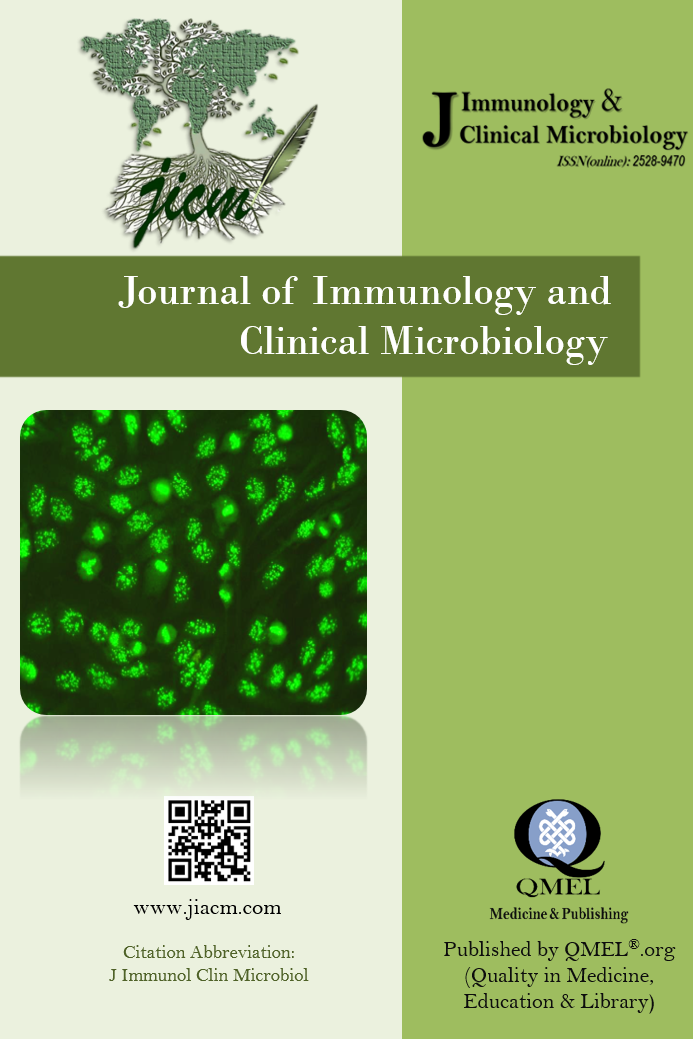Biosafety principles in parasitology laboratories
Biosafety principles in parasitology laboratories
Biosafety, Microbiology, Parasitology,
___
- 1. Sulkin SE, Pike RM. Survey of Laboratory-Acquired Infections*†. American Journal of Public Health and the Nations Health. 1951;41(7):769-81.
- 2. Pike RM, Sulkin SE, Schulze ML. Continuing importance of laboratory-acquired infections. American Journal of Public Health and the Nations Health. 1965;55(2):190-9.
- 3. Pike RM. Laboratory-associated infections: summary and analysis of 3921 cases. Health laboratory science. 1976;13(2):105-14.
- 4. Pike R. Past and present hazards of working with infectious agents. Archives of pathology & laboratory medicine. 1978;102(7):333-6.
- 5. Harding AL, Byers KB. Epidemiology of laboratory-associated infections: Biological safety: principles and practices. 3rd ed. Washington, DC: ASM Press; 2000.
- 6. Vesley D LJ, Hawley R. Decontamination, sterilization, disinfection, and antisepsis. In: Fleming DO, Hunt DL, editors. Laboratory safety: principles and practices. 3rd ed. Washington, DC:2001. 383-402 p.
- 7. M F. Developing indicators for sterilization. In: Rutala W, editor. Disinfection, sterilization and antisepsis in health care. Washington, DC1998. 119-32 p.
- 8. M. F. Sterility assurance: concepts for patient safety. In: Rutala W, editor. Disinfection, sterilization and antisepsis: principles and practices in healthcare facilities. Washington, DC: Association for Professionals in Infection Control and Epidemiology, Inc; 2001.
- 9. Prevention CfDCa. Guidelines for Environmental Infection Control in Health-Care Facilities 2003. Available from: http://www.cdc.gov/hicpac/pubs.html.
- 10. Organization WH. Laboratory biosafety manual: World Health Organization; 2004.
- 11. Florida Uo. Biological Safety Manual. Safety DoEHa, editor. Florida: University of Florida; 2008.
- 12. McIntosh IB, Dorgan CB, Dorgan CE. ASHRAE laboratory design guide: American Society of Heating, Refrigerating and Air Conditioning Engineers, Incorporated; 2001.
- 13. Health UDo, Services H. HHS Publication No.(CDC) 21-11: Biosafety in Microbiological and Biomedical Laboratories. Washington DC: US Government Printing Office; 2009.
- 14. Institution BS. Microbiological safety cabinets. Recommendations for selection, use and maintenance. London1992.
- 15. Richmond JY, McKinney RW. Primary containment for biohazards: selection, installation and use of biological safety cabinets. Washington, DC, United States Department of Health and Human Services/Centers for Disease Control and Prevention/National Institutes of Health; 2000.
- 16. Standards B, Institution. Microbiological safety cabinets. Recommendations for information to be exchanged between purchaser, vendor and installer and recommendations for installation. London1992.
- 17. Association CS. Biological containment cabinets (Class I and II): installation and field testing. Standard Z316. 1995:3-95.
- 18. International SA. Biological safety cabinets – biological safety cabinets (Class I) for personnel and environment protection. Sydney1994.
- 19. International SA. Biological safety cabinets – laminar flow biological safety cabinets (Class II) for personnel, environment and product protection. Sidney1994.
- 20. Clark JD, Gebhart GF, Gonder JC, Keeling ME, Kohn DF. The 1996 guide for the care and use of laboratory animals. ILAR journal. 1997;38(1):41-8.
- 21. Control CfD, Prevention, Health NIo. Biosafety in microbiological and biomedical laboratories (BMBL). Biosafety in microbiological and biomedical laboratories (BMBL): Department of Health and Human Services; 1999.
- 22. Richmond J, Quimby F, Zak O, Sande M. Considerations for working safely with infectious disease agents in research animals. Handbook of animal models of infection. London, Academic Press; 1999.
- 23. Hunt GJ, Tabachnick WJ. Handling small arbovirus vectors safely during biosafety level 3 containment: Culicoides variipennis sonorensis (Diptera: Ceratopogonidae) and exotic bluetongue viruses. Journal of Medical Entomology. 1996;33(3):271-7.
- 24. Hygiene. ACoMEASoTMa. Arthropod containment guidelines. A project of the American Committee of Medical Entomology and American Society of Tropical Medicine and Hygiene. Vector borne and zoonotic diseases (Larchmont, NY). 2003;3(2):61-98.
- 25. Furr AK. CRC handbook of laboratory safety: CRC press; 2000.
- 26. Lenga RE. The Sigma-Aldrich library of chemical safety data. Ed. 21988.
- 27. Turkey moeafRo. Legislation of Control of Medical Waste. Ankara: The duties of the General Directorate of Development of Legislation and Publication; 2005.
- 28. Association IAT, editor Infectious substances shipping guidelines 2009: IATA.
- 29. committee EcfEIt. Restructured ADR Applicable as from 1 January 2003: European Agreement: Concerning the International Carriage of Dangerous Goods by Road: UN; 2002.
- 30. Europea U. Council Directive 98/81/EC of 26 October 1998 amending Directive 90/219/EEC on the contained use of genetically modified microorganisms. Official Journal of the European Communities L.330.
- 31. O'Malley BW, Li D, Buckner A, Duan L, Woo SL, Pardoll DM. Limitations of adenovirus‐mediated interleukin‐2 gene therapy for oral cancer. The Laryngoscope. 1999;109(3):389-95.
- 32. Organization WH. Maintenance and distribution of transgenic mice susceptible to human viruses: memorandum from a WHO meeting. Bulletin of the World Health Organization (WHO). 1993;71(5):497-502.
- Yayın Aralığı: Yılda 4 Sayı
- Başlangıç: 2016
- Yayıncı: Erkan YULA
Gülseren YİLMAZ, Ziya SALİHOGLU
Emrah ERDOĞAN, Abdüssamed AKŞİT, Ahmet GÜRGEL, Serkan KARACA, Bora ÖZKAN
Biosafety principles in parasitology laboratories
Abdüssamed AKŞİT, Emrah ERDOĞAN, Serkan KARACA, Bora ÖZKAN, Ahmet GÜRGEL, Merve YÜRÜK, Eda SİVCAN, Bekir TARTICI, Yunus UYAR
Barsak Mikrobiyotasının Nörodejeneratif Hastalıklar Üzerindeki Patofizyolojik Rolü
